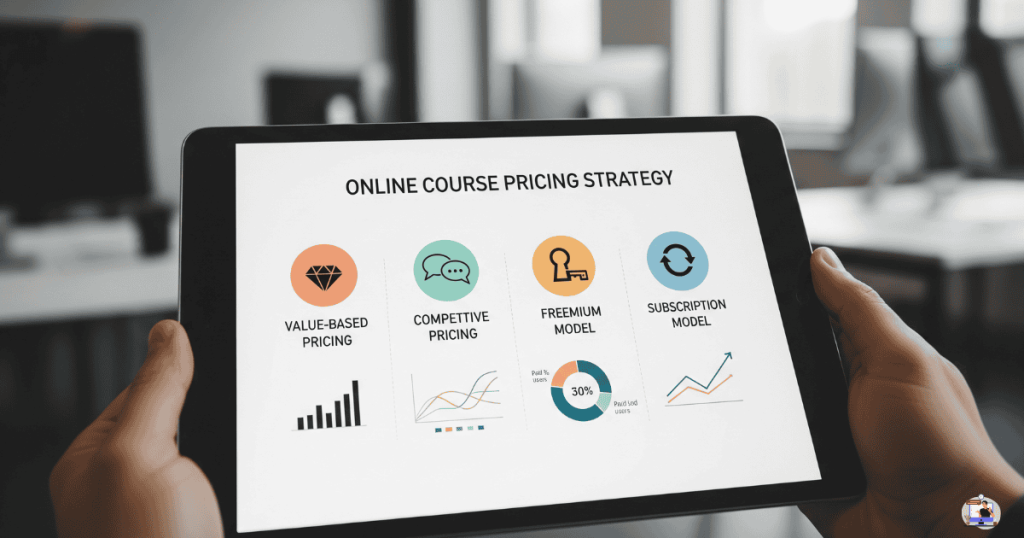Online Course Pricing: Psychology-Backed Strategies to Set Prices That Sell

Setting the right price for your online course can feel like trying to solve a complex puzzle. The price is too high, and potential students scroll past. Price too low, and you undervalue your expertise while struggling to cover costs. The secret lies in understanding the psychological forces that drive purchasing decisions.
Course pricing psychology goes far deeper than simple cost calculations or competitor analysis. It taps into how the human brain processes value, makes comparisons, and justifies spending decisions. When you master these psychological principles, you can set prices that not only attract students but also position your course as the valuable educational investment it truly is.
This comprehensive guide will walk you through the mental triggers that influence online course purchasing decisions and provide actionable strategies to optimize your pricing for maximum enrollment and revenue.
Why Psychology Matters More Than Math in Online Course Pricing

Traditional pricing advice often focuses on formulas: calculate your costs, research competitors, and add a profit margin. While these elements matter, they miss the crucial component of how students actually make buying decisions.
Behavioral economics research, such as studies shared by Stanford Graduate School of Business, shows that price perception involves complex mental processes. Students assess perceived value, compare options, and navigate emotional responses to different price points. Understanding these psychological mechanisms gives you a significant advantage in pricing strategies for online courses.
The most successful course creators recognize that pricing is fundamentally about communication. Your price tells a story about quality, exclusivity, and transformation. It sets expectations and influences the entire student experience, from initial interest to course completion rates.
The Anchoring Effect: How First Impressions Shape Price Perception
Price anchoring represents one of the most powerful tools in course pricing psychology. This cognitive bias causes people to rely heavily on the first price they encounter when making subsequent judgments about value.
Smart course creators leverage anchoring by strategically presenting their pricing structure. If students first see your premium package at $997, your standard course at $497 suddenly appears more reasonable and accessible. This isn’t about manipulation—it’s about helping students understand the relative value of different options.
Consider implementing tiered pricing to maximize the anchoring effect. Start with your highest-value package, then present progressively more affordable options. This approach naturally guides students toward your preferred price point while making them feel they’re getting excellent value.
You can also use external anchors to your advantage. Mention the cost of traditional education, one-on-one consulting, or the financial impact of the problem your course solves. These comparisons help students contextualize your course price within a broader value framework.
Value Perception and the Premium Pricing Paradox
Higher prices often signal higher quality—a phenomenon known as the premium pricing paradox. Students frequently associate expensive courses with superior content, better outcomes, and more prestigious credentials.
This psychological principle explains why some course creators successfully charge $2,000 or more for programs that cover similar ground to $99 courses. The higher price creates an expectation of premium value, which can actually enhance the learning experience through increased commitment and attention.
However, leveraging premium pricing requires careful execution. Your course must deliver genuine value that justifies the higher price point. Consider these elements when positioning your course at premium prices:
Comprehensive curriculum depth that goes beyond surface-level information. Expert credentials and proven track record of student success. Exclusive access to tools, templates, or resources not available elsewhere. Personal interaction opportunities, like office hours or community access. Clear transformation outcomes with specific, measurable benefits.
The key lies in aligning price with genuine value while understanding that price positioning strategies can influence how students perceive and experience that value.
Decoy Pricing: Guiding Decisions with Strategic Options
The decoy effect occurs when adding a strategically inferior option makes your preferred choice appear more attractive. This technique proves particularly effective for online course value perception.
Here’s how it works: imagine you offer a basic course for $197 and a comprehensive version for $297. Many students might choose the cheaper option. But add a middle option—perhaps the basic course plus a few bonuses for $277—and suddenly the $297 comprehensive course looks like an incredible value.
The middle option serves as a decoy, making your premium offering appear more attractive without actually competing for sales. Students rarely choose the decoy, but its presence influences their decision-making process toward your preferred option.
When implementing decoy pricing, ensure the decoy feels genuine rather than artificially constructed. It should offer real value while being clearly inferior to your main offering in terms of value per dollar spent.
The Power of Price Anchoring in E-Learning
Price anchoring in e-learning extends beyond simple high-to-low presentation. Consider these advanced anchoring techniques:
Time-limited introductory pricing creates urgency while establishing a higher reference point. Students who purchase at the introductory rate understand they’re receiving exceptional value, while future buyers will anchor to the higher regular price.
Bundle anchoring involves presenting your course alongside related products or services. If your consulting rate is $200 per hour, your 20-hour course is equivalent to $497 appears remarkably affordable.
Outcome anchoring connects your price to the financial or personal value students will receive. A course that helps freelancers raise their rates by $25 per hour justifies a significant investment based on potential returns.
Social anchoring leverages testimonials that mention price satisfaction. When students see others expressing that the course was “worth every penny” or “would have paid twice the price,” it reinforces value perception.
Psychological Pricing Models for Digital Products

Different pricing models trigger distinct psychological responses. Understanding these can help you choose the optimal approach for your course:
A one-time payment creates a sense of ownership and finality. Students appreciate avoiding ongoing commitments, making this model effective for self-paced courses with lifetime access.
Payment plans reduce the psychological burden of large upfront costs while often increasing total revenue through convenience fees. The monthly payment feels more manageable, even if the total cost exceeds the one-time price.
Tiered subscriptions work well for ongoing content or community access. This model creates recurring revenue while allowing students to adjust their investment level based on engagement and results.
Performance-based pricing ties cost to outcomes, reducing purchase risk while commanding premium rates. This approach works particularly well for business or skill-development courses with measurable results.
Choose your pricing model based on your course content, target audience’s financial preferences, and desired revenue structure.
Understanding Student Willingness to Pay
Student willingness to pay depends on multiple psychological factors beyond simple affordability. Pain point intensity significantly influences price sensitivity—students facing urgent, expensive problems will invest more in solutions.
Perceived expertise also impacts willingness to pay. Students pay premium prices for courses taught by recognized authorities, published authors, or successful practitioners. Building your credibility through content marketing, speaking engagements, and student success stories increases price acceptance.
Social proof plays a crucial role in justifying higher prices. Testimonials, completion rates, success stories, and enrollment numbers help students feel confident about their investment decision.
The format and experience quality affect price perception as well. Professionally produced videos, interactive elements, downloadable resources, and community access justify higher prices than basic video lectures.
Consider conducting surveys or interviews to understand your audience’s price sensitivity and value priorities. This research provides valuable insights for optimizing your course pricing strategy.
Premium vs Budget Course Positioning
The choice between premium and budget positioning involves more than price points—it’s about market positioning and student experience design.
Premium course pricing typically ranges from $497 to $2,997 or higher. This positioning attracts students who value exclusivity, comprehensive content, and high-touch experiences. Premium students often show higher completion rates and engagement levels due to their increased financial commitment.
Budget positioning generally falls between $47, $197, appealing to price-conscious students or those new to online learning. While individual transaction values are lower, this approach can achieve higher conversion rates and larger audience reach.
Middle-market positioning ($197 to $497) attempts to balance accessibility with quality perception. This range often provides optimal revenue for courses with solid value propositions but without premium positioning elements.
Your choice should align with your expertise level, course depth, target audience, and business goals. Consider starting with thorough market research to understand where your ideal students expect your course to be positioned.
Advanced Pricing Psychology Techniques
Loss aversion suggests people feel losses more strongly than equivalent gains. Frame your course price in terms of what students lose by not taking action rather than what they gain by enrolling.
Social validation through enrollment counters, recent purchase notifications, or community size indicators can justify higher prices by demonstrating demand and social acceptance.
Scarcity and urgency create psychological pressure that can overcome price objections. Limited-time bonuses, cohort-based enrollment, or exclusive access opportunities encourage faster decision-making.
Reciprocity principles involve providing valuable free content that creates a sense of obligation. When students receive significant value upfront, they’re more willing to invest in comprehensive paid programs.
Commitment consistency suggests that students who make public commitments or small initial investments are more likely to follow through with larger purchases. Free challenges or low-cost introductory products can lead to higher-value course sales.
How to Increase Course Sales Through Strategic Pricing

Optimize your sales conversion by testing different price points and presentation methods. A/B testing can reveal surprising insights about your audience’s price sensitivity and preferences.
Create urgency through limited-time promotions, but avoid overusing this technique as it can reduce credibility. Instead, tie urgency to genuine factors like cohort start dates or bonus expiration.
Implement payment plan options to reduce the psychological burden of higher prices. Even a two-payment option can significantly increase conversion rates while maintaining revenue.
Use testimonials that specifically address value and price satisfaction. Students want reassurance that others found the investment worthwhile.
Consider offering a money-back guarantee to reduce purchase risk. The security of a refund option can justify higher prices and often results in fewer actual refund requests.
Dig Deeper: Effective Information Technologies Course Promotion Ideas
Online Course Pricing Strategy: Testing and Optimizing Your Course
The Successful Pricing Strategy Course Online requires ongoing optimization based on real market feedback. Start with a thorough competitor analysis, but remember that direct price matching ignores the unique value you provide.
Track key metrics beyond simple conversion rates. Monitor student satisfaction scores, completion rates, refund requests, and long-term student success. These indicators help determine whether your pricing strategy supports sustainable business growth.
Consider seasonal adjustments based on your audience’s buying patterns. Professional development courses might see higher sales in January and September, while hobby-based courses might peak during summer months.
Test different pricing presentations, including currency formatting, payment plan options, and value emphasis. Small changes in presentation can yield significant improvements in conversion rates for your Pricing Strategy Course Online.

Building a Sustainable Pricing Framework
Create a systematic approach to pricing decisions that can guide future course launches. Document what works for your audience and market segment.
Consider the lifetime value of students rather than just initial course sales. Students who have positive experiences become repeat customers and valuable referral sources. Offering a course bundle can further increase lifetime value by encouraging students to invest in multiple programs at once, maximizing both impact and revenue.
Build pricing flexibility into your strategy. Market conditions change, and successful course creators adapt their pricing to maintain competitiveness while preserving profitability.
Remember that pricing is just one element of your overall value proposition. Focus equally on course quality, student support, and learning outcomes to justify your chosen price points.
Your pricing strategy should evolve as your expertise grows, your audience develops, and market conditions shift. Regular review and adjustment ensure your prices continue to support both student success and business sustainability.



